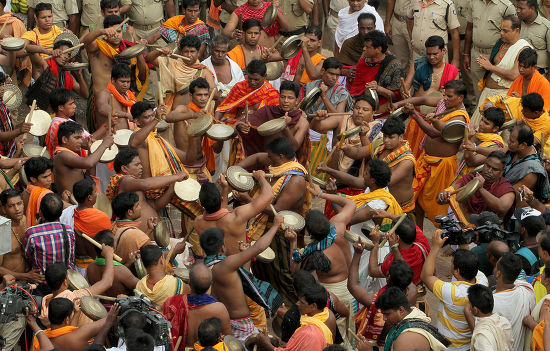Bahuda Jatra – June 28
Without the resounding beats of the drums, the lyrical strains of the conch shells, and the heart-stirring sounds of the cymbals, Ratha Jatra would be incomplete. These instruments are essential in fostering a fervent spiritual environment that enthrals both participants and onlookers. Ratha Jatra is enhanced by its beautiful songs and dynamic rhythms, which reaffirm the popular festival’s cultural heritage, customs, and sense of devotion.
Instruments like the Ghanta and Kahali emerge as important companions, bringing life to the auspicious voyage amid the pulsating beats of the drums and the soaring melodies.
Each musical instrument is allotted to a specific group of sevayats and is a crucial component of Lord Jagannath’s journey to Gundicha Temple. While the ‘Madeli’ plays the madala (a long drum) during bedtime rites, the ‘Veenakara’ plays the veena when putting the gods to sleep. Similarly, the ‘Ghantua’ group plays cymbals during the Pahandi procession, the ceremony of transporting the gods to the chariot and the ‘Shankha’ group blows conch shells during the ceremonies of the Lord and His siblings.
“Music calms the nervous system. The Lord needs to unwind through music just like people do. These customs were established by kings who saw the Lord as an extension of themselves,” according to researcher Jayanti Rath.
Ahead of Bahuda Jatra, a few ‘Ghantua’ and ‘Kahalia’ families, who participate in the annual Ratha Jatra every year, told Sunday POST about the customs in detail before the Bahuda Jatra.
For the past 20 years, Chandrasekhar Sahoo, a servitor from Markandeswar Sahi in Puri, has been offering the Ghanta seva. ‘Ghantuas,’ or people who play the Ghanta (gong), are essential to the Ratha Jatra, according to Sahoo. The ‘Ghantuas’ are divided into groups and given the task of entertaining the chariots in front of them. The number of wheels on each chariot is taken into consideration while determining the strength of each group. Taladhwaja, the Lord Balabhadra’s chariot, has 14 wheels, for instance. In this way, two ‘Ghantuas’ are allocated to each wheel, giving Taladhwaja a group of 28 ‘Ghantuas’. Similar to this, 24 and 32 ‘Ghantuas’ respectively, perform in front of Nandighosha, the chariot of Lord Jagannath, and Darpadalana, the chariot of Devi Subhadra.
The gong, according to him, is known as Bijaya Ghanta. When the gods are in Ratna Simhasana or Ratna Bedi, the Ghantas cannot be played. Only during Pahandi, when the Trinity leaves the Srimandir, do the ‘Ghantuas’ begin their performances. The wheels of the chariots begin to move to the beat of the Ghantas, similar to welcome music, he says. The entire ritual is carried out till the chariots arrive at the Gundicha Temple, with a brief stop during Chhera Pahanra, he further says.
“My family has been performing this service for ages now. Over the years, the service has been carried out by my brothers and nephews. I’ve been in charge of it for more than 20 years. We are ‘Ghantuas’ because the temple management designated us, but we fulfill our duty out of love and devotion. We can play nonstop for 20 hours without getting weary,” he claims.
Similar to ‘Ghantuas’, ‘Kahalias’ are crucial when the gods leave the temple during Ratha Jatra. Before the gods set out on their voyage, ‘Kahalias,’ or people who play the Kahali (a musical instrument that resembles a clarion or trumpet without a reed), begin their performance.
According to a local of Markandeswar Sahi, Lord Jagannath’s chariot, Nandighosha, will not proceed until Subhas Chandra Mohanty plays the ceremonial trumpet Bije Kahali.
The Mohantys have been carrying out the ritual for years and the family is a member of the Kahalia group of servitors. For every chariot festival for the past 13 years, he has had to perform this task. The ceremony had been carried out for 35 years prior to him by his older brother. “We should be proud that we have this chance to serve the Lord. I experience a different kind of strength each time I do this. It puts me in a trance,” claims Mohanty.
The trumpet is handcrafted by craftsmen in Cuttack and weighs around 400 grams. The trumpet is created using a unique procedure. It can only be manufactured inside the Puri temple with specific dimensions, continues Mohanty.
They offer more than just chariot festival services. During many significant events of the Srimandir and the Trinity, they blow the bugle as an invocation.
“We provide service year-round. We must sound the trumpet four times each night to signal the beginning of the Lord’s many rites. In addition to that, we provide service on holidays and other events,” Mohanty says.
According to him, seven members of his family are currently responsible for carrying out the task.
MADHUSMITA SAHU, OP







































